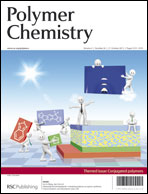Donor–acceptor conjugated polymers based on the novel donor 3,7-didodecyl-2,6-di(thiophen-2-yl)benzo[1,2-b:4,5-b′]difuran, and 1,4-diketopyrrolo[3,4-c]pyrrole as the acceptor were synthesized via the Stille cross-coupling reaction. The alkyl chains on the diketopyrrolopyrrole monomers were varied to engineer the solubility and morphology of the materials. Thiophene and furan moieties were used to flank the DPP group and the impact of these heterocycles on the polymers' properties evaluated. All of the polymers have similar optoelectronic properties with optical band-gaps of 1.3–1.4 eV, LUMO levels of −3.7 to −3.8 eV and HOMO levels of −5.5 to −5.6 eV. The furan-containing polymers have better solubility than the all-thiophene polymers, as significantly higher molecular weight materials of the former were readily dissolved. When the polymers were used as donor materials along with PC71BM as the electron-acceptor in bulk-heterojunction photovoltaic cells, power conversion efficiencies of up to 2.9% were obtained, with the furan-containing polymers giving the best results.
![Graphical abstract: Influence of heteroatoms on photovoltaic performance of donor–acceptor copolymers based on 2,6-di(thiophen-2-yl)benzo[1,2-b:4,5-b′]difurans and diketopyrrolopyrrole](/en/Image/Get?imageInfo.ImageType=GA&imageInfo.ImageIdentifier.ManuscriptID=C3PY00138E&imageInfo.ImageIdentifier.Year=2013)
You have access to this article
 Please wait while we load your content...
Something went wrong. Try again?
Please wait while we load your content...
Something went wrong. Try again?
![Graphical abstract: Influence of heteroatoms on photovoltaic performance of donor–acceptor copolymers based on 2,6-di(thiophen-2-yl)benzo[1,2-b:4,5-b′]difurans and diketopyrrolopyrrole](/en/Image/Get?imageInfo.ImageType=GA&imageInfo.ImageIdentifier.ManuscriptID=C3PY00138E&imageInfo.ImageIdentifier.Year=2013)

 Please wait while we load your content...
Please wait while we load your content...